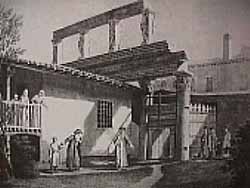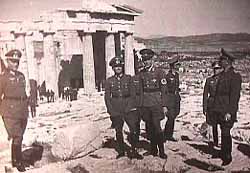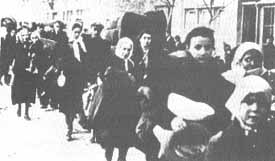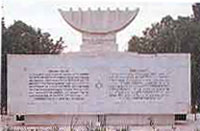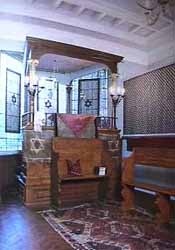Greece Virtual Jewish History Tour
By Shira Shoenberg
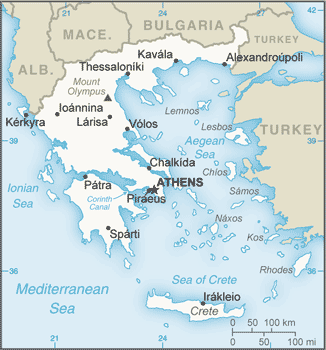 |
Greece is a small country by the Mediterranean Sea where the first European civilization began more than 2,000 years ago. About one-fifth of the country is made up of islands, and no part of Greece is more than 85 miles from the sea. The achievements of ancient Greece in government, science, philosophy, and the arts are considered the foundations of western culture. Greece came under the control of invaders more than 2,000 years ago and did not gain independence until 1829. Today, the Jewish population of Greece stands at approximately 4,100 people.
Early Jewish Community
Ottoman Rule
Thessaloniki & Athens
World War II
Modern Greece
Relations with Israel
The Greek Islands
Jewish Tourist Sites
Jewish Community Contacts
Early Jewish Community
|
Learn More - Cities of Greece: |
Contact between Greeks and Jews outside of Greece began after the Babylonian exile of 586-539 B.C.E. When the Persian king Cyrus allowed Jews to return to their homeland after the Babylonian exile, they met Greeks for the first time. The prophet Ezekiel wrote of the Greek traders of “Javan,” Ionia, who traded in slaves and worked with bronze. The Greek historian Herodotus knew of the Jews, whom he called Palestinian Syrians, and included them in his list of those serving in the Persian king Xerxes’ navy when Xerxes invaded Greece in 480 B.C.E.
There may have been isolated Jews living in Greek cities as far back as the Babylonian exile, but the first organized Jewish communities in Greece were established in approximately 400 B.C.E. The communities flourished during the reign of Alexander the Great and the subsequent Hellenistic period in around 300 B.C.E. Jewish immigrants flooded Hellenist cities along the Aegean Coast and the Greek mainland. The Greeks were polytheistic and maintained a glamorous lifestyle. While most Jews retained their monotheism, many wealthy Jews were attracted to Greek culture and created a class of assimilated, pro-Greek Jews.
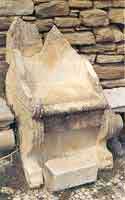 Throne of Moses in the Synagogue of Delos from 1st Century |
Greek was the language of commerce, administration, and secular law in the Hellenistic kingdoms, and, slowly, Jewish communities began to forget Hebrew. In around 260 B.C.E., certain books of the Bible began appearing in Alexandria in Greek translation. In approximately 250 B.C.E., the Macedonian-Egyptian king Ptolemy ordered the translation of the entire bible into Greek by 70 scholars. This translation became known as the Septuagint.
The most famous confrontation between Greeks and Jews was the Maccabean Revolt of 167-164 B.C.E. The Seleucid king Antiochus IV imposed Greek religious customs on the Jews and tried to convert the Jewish temple in Jerusalem into a temple to the Greek god, Zeus. The Jewish revolt, led by the Hasmonean Judas Maccabee, defeated the Seleucid armies and recaptured the temple. After the revolt, many Hellenized Jews left Judea and moved to Hellenistic commercial centers such as Alexandria and Antioch.
According to Maccabees I 15:23 and also the Jewish historian Philo (c. 30 B.C.E.–c. 45 C.E.), in the years following the revolt, the Jews built up communities in Sparta, Delos, Sicyon, Samos, Rhodes, Kos, Gortynia, Crete, Cnidus, Aegina, Thessaly, Boeotia, Macedonia, Aetonia, Attica, Argos, Corinth, and Cyprus. When the Christian Saint Paul visited Greece during the first century C.E., he found well-established Jewish communities in Thessaloniki, Veroia, Athens, Corinth, and other towns.
The Jews in these communities were called “Romaniot,” a Hellenized Latin term implying that they lived in the empire of the “second Rome,” meaning Greece. They developed customs now known as “minhag Romania.” They translated traditional Jewish prayers into Greek and recited them in Greek, although the prayers were written with Hebrew letters. The Jews’ political existence was tenuous, and “they absorbed from the Greeks before the birth of Christ more than the Greeks absorbed from them” (Levi, p. 203).
These communities of Romaniot developed throughout the Byzantine period, which lasted from approximately 476-1453 C.E. Life was not always easy for the Jews, and they were pressured to accept the Christian Messiah, but they were also recognized as descendants of the Chosen People, and protected by the law. Many Jewish communities identified themselves with certain industries. For example, the community of Thebes, which consisted of 2,000 Jews, dominated the silk industry, while Crete’s Jews were producers and exporters of agricultural goods. Many Jews integrated into Greek culture. Some communities tried to maintain Hebrew by writing out sections of the Tanakh in Greek using Hebrew script. Many communities lost Hebrew entirely and still more assimilated completely and lost all identity as Jews. During the 9th-12th centuries, many Central European Ashkenazi Jews who were scared by the Crusaders‘ persecutions found refuge in Northern Greece, in Thessaloniki (Salonika).
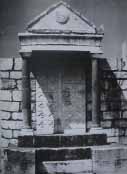 Synagogue of Sardes, c. 350 C.E. |
Ottoman Rule
In 1453, the Ottoman Turks captured Constantinople, the Byzantine capital, and began to rule over all of Greece. The Ottoman policy was based on Islamic law, which recognized the Jews as a separate nation with religious and often legal autonomy within their own communities. Greece became a haven of religious tolerance for Jews fleeing the Spanish Inquisition and other persecution in Europe. The Ottomans welcomed the Jews because they improved the economy. Jews occupied administrative posts and played an important role in intellectual and commercial life throughout the empire. With the 1492 Edict of Expulsion against the Jews of Spain, more than 20,000 Sephardic Jews arrived in Thessaloniki in one year.
This signaled the beginning of Sephardic Jewry in Greece. Many of the Sephardim were “marranos,” Jews who had converted to Christianity in the 14th century and were used to partaking in European culture. Many times their pride and sense of cultural superiority led to friction in their dealings with the Romaniot Jews. Eventually, however, the Romaniot communities of Constantinople, Edirne, Thessaloniki, Rhodes, and many others accepted both the minhag (custom) and language of the Sephardim. Romaniot traditions remained in only a few communities, such as Yoannina and Chalkis. By the 16th century, the Sephardi language, Ladino, had become the accepted language of Greek Jewry.
|
|
By supporting the Ottoman Empire, the Jews curried disfavor with the Christian Orthodox Greeks. In 1821-1829, during the Greek War of Independence, thousands of Jews were massacred alongside the Ottoman Turks. The Jewish communities of Mistras, Tripolis, Kalamata, and Patras were destroyed. A few survivors moved north to areas still under Ottoman rule.
In the late 19th century, Greece attempted to regain the southern Balkan territories historically associated with Greek history and language. Jews and other ethnic groups were subject to “Hellenization,” a movement to force them into accepting Greek customs and language. The Romaniot Jews of southern and northwestern Greece were already Hellenized to a large extent. The Hellenization was most problematic for the Sephardim, who only came under Greek rule after the Balkan Wars of 1912-1913.
In 1922-1923, there was a mass exodus of Greeks from Asia Minor. The refugees settled on the Greek mainland and created substantial economic competition between the Jews and the Greek refugees. This created a tense climate in which the Jewish district of Kampel in Salonika was burned in 1931. The suspects were thought to belong to the fascist Ethniki Enosis Ellas (EEE, National Union of Greece), although they were never found.
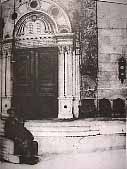 Kal Yashan Synagogue in Salonika destroyed in 1917 |
Thessaloniki & Athens
Two of the most important Jewish communities in pre-World War II Greece were Thessaloniki and Athens. In the 1600s, Thessaloniki, a Sepharadi community, became one of the largest Jewish communities in the world and was known as “ir v’em beyisral,” metropolis and mother of Israel. By 1900, more than half of the town’s population was Jewish, which was about 80,000 Jews. In 1900-1910 Thessaloniki had more than 50 synagogues, 20 Jewish schools, and numerous Jewish institutions and associations. It was a center of Torah learning for all of Europe. Business was generally conducted in the Sepharadi language of Ladino, and, on Friday afternoons, almost all commercial life stopped since most of the city’s workers were Jewish. A sprawling Jewish cemetery lay in the center of the city (the cemetery was destroyed during World War II to make room for a new university). The Jewish population was varied and included both Karaites and Donmeh (followers of the false messiah Shabbatai Zevi). The city had a strong Judaeo-Spanish culture.
The downfall of the Jewish community started with a fire in the Jewish quarter in 1917. Confiscations began in sections of the ancient cemetery and continued through the late 1930s. In the 1920s, many Greek refugees from Asia Minor flooded the city. Hellenization disrupted the Judaeo-Spanish culture by requiring the imposition of the Greek language, the establishment of Sunday instead of Saturday as a day of rest, and the reorganization of traditional religious Jewish life according to Greek laws. National and economic life in Greece became increasingly centered around Athens, and many Jews moved there. As the Thessaloniki community weakened, some of its Jews left Greece altogether. At the turn of the 20th century, the city boasted of 90,000 Jews. By 1939, there were approximately 56,000 left.
|
|
Athens retained a Jewish presence from the Middle Ages until the 1800s. There was then a notable absence of Jews in Athens following the Greek War of Independence, indicating that they were either killed or forced to flee. The first “new” Jews in the city came in 1834 when the Bavarian King Otto I of Greece settled there, along with a Jew named Max Rothschild. Rothschild was soon followed by other Bavarian, and Ashkenazi Jews, and then by a group of Jews from Turkey. By the mid-19th century, there was a small Jewish community in Athens, although it had no defining tradition, as did the community in Thessaloniki.
The Jews in Athens were never completely secure politically. During the 1840s, Easter celebrations in Athens included the ritual burning of a symbolic “Judas.” In 1847, Rothschild persuaded the Greek Prime Minister to stop this practice. The public then focused its attention on a Gibraltar-born Jew of questionable business integrity named Don Pacifico. Rioters sacked his house and burned his warehouse. In 1854, the eccentric French-American aristocrat Sophie Berbe Marboise left a considerable amount of property to the Athens Jewish community. The Jews of Athens were in no position to claim the gift, however, and never received any of the land.
Despite this insecurity in society, the Athens community was well-established by the late 1800s. It was legally organized in 1885, and its official charter was granted in 1889. A synagogue was built in 1904 and dedicated as Etz Hayyim in 1906. By the 1940s, the synagogue accommodated more than 3,000 people.
World War II
At the start of World War II, Greek Prime Minister Ioannis Metaxas tried to maintain neutrality. On October 28, 1940, Italy demanded that Greece give up its sovereignty. Metaxas refused and, when Italy invaded, pushed the Italians back. On April 6, 1941, the Germans invaded Greece, and, on April 18, the Greek government fled to Crete. On April 21, the Germans overran Athens and, on May 20, they took Crete.
|
|
The Germans divided Greece into three occupation zones. The Germans held western Macedonia, Thessaloniki, a strip of land in eastern Thrace, the major Aegean Islands, and Crete. The Bulgarians were given eastern Macedonia and Thrace. The Italians received the Dodecanese Islands, the Ionian Islands, and a large section of mainland Greece including Athens. At that time, approximately 76,000 Jews lived in Greece: 55,000 in Salonika in the German zone, 6,000 in western Thrace under Bulgaria, and 13,000 under Italian control.
Several Greek resistance organizations were founded, including the communist National Liberation Front in September 1941, the republican National Republican Greek League in the summer of 1942, and National and Social Liberation in the summer of 1943.
The German Occupation Zone
As soon as the Germans entered the Greek mainland, they implemented anti-Jewish policies. The first Jewish community to be affected by the Final Solution was Thessaloniki in the German zone. The Nazis occupied the city on April 8, 1941. They aroused anti-Semitic sentiments in the Christian Greek populations and revived several anti-Semitic publications that had been suppressed during Metaxas’ rule. On April 15, the council of the Jewish community was arrested and replaced. In June 1941, the Nazi Jewish Affairs Commission, a.k.a. the Rosenberg Commando, began confiscating Jewish libraries, manuscripts, and art and sending it to Germany.
In the winter of 1941-1942, refugees from Thrace, eastern Macedonia, and the Bulgarian territory ran to Thessaloniki and Athens. The food supplies of Thessaloniki gave out, and starvation and typhus were rampant. The Nazis conducted summary arrests and executions. Approximately 60 Jews died each day.
In July 1942, 9,000 Jews of Salonika were called to forced labor. In October, a ransom was set by the German civilian administrator of Salonika, Max Merten, to redeem these men and the 1.9 billion drachmas that the Jews paid drained all the community’s wealth. He collected jewelry, antiques, cash and anything else of value and supposedly loaded the treasure onto a fishing boat that sank. On December 6, the Jewish cemeteries of Thessaloniki were confiscated and pillaged.
The Rosenberg Commando demanded in early 1943 that parts of the 1935 Nuremberg Laws were to be put into effect. Jews had to wear a Star of David, and Jewish stores and residences were similarly marked. The Nazis formed three ghettos and concentrated the Jews within them. Jewish organizations were banned, and Jews were forced to register their belongings. On March 15, deportations began. In the next three months, 45,649 Jews were sent from Thessaloniki to Auschwitz. Only a handful survived.
Merten brazenly returned to Greece after the war to search for his lost loot. In 1958, a survivor spotted him and told the police. He was arrested, tried and sentenced to 25 years in prison. The Greek Prime Minister, however, sent him to Germany after just eight months. He was retried there and acquitted for lack of evidence that he had rounded up Jews and stolen their property. He died in Germany. In 2000, a group of divers planned to search the Greek coast for the estimated $2.4 billion worth of treasure (Jerusalem Report, July 17, 2000).
|
|
The Bulgarian Occupation Zone
Many members of the Bulgarian Orthodox Church and the Bulgarian public helped the Jews, but the government supported the Nazis. On November 12, 1942, the Bulgarian government stated that it “readily accepts the proposals of the German government to carry out the general evacuation of the Jews from Bulgaria” (Stavrolakis). That same month, the government instituted the provisions of the Nuremberg Laws, forcing Jews to wear a Star of David, submit a record of family wealth, live in proscribed areas and abide by a 5:00 pm curfew. In January 1943, a commission confiscated all Jewish valuables. On March 4, 1943, all Jews under the Bulgarian Occupation were arrested and imprisoned. About 200 escaped. The other 4,100 were deported to Treblinka. The extermination of Jews in the German and Bulgarian zones was completed by the summer of 1943.
The Italian Occupation Zone
Those Jews living in the Italian zone were relatively well off during most of the war. Jews in the Italian zone were ignorant of Auschwitz and thought that the German racial laws had been applied only to remove the Judaeo-Spanish bloc in Thessaloniki. The Italians helped hundreds of Jews escape to Athens and issued more than 300 false identity papers. The clergy hid more than 250 Jewish children. In Athens, the Jews were integrated into the city’s life and were externally no different from their Christian neighbors. They did not believe that the fate of the Jews of Thessaloniki could affect them.
On September 8, 1943, the Italians surrendered to Allied forces invading Italy. The Germans then arrested the Italians in Greece and started the last phase of their “action” against the Greek Jews. On September 20, the Rosenberg Commando arrived in Athens. It demanded a list of the names and addresses of all Jews residing in Athens and of all those who had helped Jews escape. It created a council under Chief Rabbi Elias Barzilai to carry out Nazi orders. The Jews, however, destroyed the community records so they could not fall into Nazi hands. They helped Barzilai escape to the partisans. On the eve of Yom Kippur, October 8, 1943, the order was given to reorganize the Jewish community under direct Nazi supervision. Jews were ordered to register their names within five days. By the end of October, only 200 Jews registered. Many Jews left by boat, many joined partisan camps in the mountains, and some converted. Most went into hiding. By March 1944, however, about 1,500 Jews had registered either to receive permission to work or out of fear of reprisals against Christian neighbors who were hiding them. On March 24-25, 800 Athenian Jews were sent to Auschwitz. Throughout the summer, about 3,500 Jews from other cities in the Italian zones joined these Athenian Jews in Auschwitz.
The End of the War
A total of at least 54,533 Greek Jews were sent to Auschwitz, despite the protests of many Greek leaders. Most of these Jews were murdered, though many were also involved in various acts of resistance. In September 1944, the Germans evacuated the Greek mainland. In May 1945, they gave up the last of the Greek islands under their control. In total, the Germans confiscated 280 million drachmas ($1.5 million) in cash from Greek Jews, plus property. Between 60,000 and 65,000 Greek Jews died in the Holocaust, though there were several Jewish communities that at least partially survived the war. In 1945, the total Jewish population in Greece was 10,000.
In December 2012, police in northern Greece recovered 668 fragments of marble headstones and other parts of Jewish graves that were destroyed during the Nazi occupation of Greece in World War II. After a 70-year search for the remains of graves smashed when Thessaloniki’s main Jewish cemetery was destroyed, the fragments were found buried in a plot of land in the center of the city. According to the head of Thessaloniki’s Jewish community, David Saltiel, most of the gravestones found dated from the mid-1800s up until World War II.
In March 2013, Greek Jews gathered to commemorate the 70th anniversary of the first roundup and deportation of Greek Jews to Nazi extermination camps during the Holocaust. A few hundred people came together at the city’s Eleftherias (Freedom) Square, the very spot where the occupying Nazi forces rounded up the first group of Greek Jews on March 15, 1943.
Modern Greece
|
|
In 1944, the government of George Papandreou was the first European government to return Jewish properties that had been confiscated during the war. The property of the deceased was put in a common fund to aid Jews impoverished by the war. A royal decree in 1949 established the Foundation for the Welfare and Rehabilitation of the Jewish Community in Greece. According to the decree, Jewish survivors and their heirs could present claims in court for restitution or compensation for the property.
Since the Holocaust, there have been some anti-Semitic and Anti-Zionist incidents in Greece. Under the rule of the socialist party PASOK in the 1980s, pro-socialist papers compared Israel to the Nazis after Israel’s invasion of Lebanon and called for a boycott of Jewish shops. There are a few far-right, anti-Semitic organizations and movements, but their activity is generally minimal. There are also some anti-Semitic or Anti-Zionist publications, with somewhat considerable circulation. The most common manifestation of anti-Semitism is graffiti of swastikas and neo-Nazi symbols.
The Greek far-right political party “Golden Dawn” is described by scholars, the media, and the international community as antisemitic, fascist, and antizionist. Golden Dawn began in 1980 as the brainchild of Nikolaos Michaloliakos but was not registered as an official Greek political party until 1993. After 30 Golden Dawn members attacked a group of students outside of Athens University of Economics and Business in 1992, they began to become a household name in Greece and increased recruitment practices. The party was active from 1993-2005 and resumed political activity in 2007. The Golden Dawn gained a lot of political support during Greece’s economic downturn by campaigning on concerns about unemployment, austerity, and immigration. The 2012 election saw the Golden Dawn win more support from the Greek voters, and they received 7% of the popular vote. This was enough to land them seats in the Hellenic Parliament for the first time, with 21 seats won.
Golden Dawn members have been accused of carrying out acts of violence against Jewish individuals, immigrants, LGBT individuals, political opponents, and ethnic minorities. They have desecrated and vandalized synagogues attacked innocent people on the street, and murdered political opponents such as Pavlos Fyssas. Their symbol is strikingly similar to the Nazi swastika, and they openly perform Nazi salutes and sell World War Two-era Nazi propaganda. The Golden Dawn party is a dangerous and antisemitic organization that appears to be edging ever closer to the Nazi ideology.
In response to the surge in popularity of the Golden Dawn party, Greece’s Parliament cracked down on hate speech. The Parliament approved a law on September 10, 2014, that bans Holocaust denial or trivialization and increases jail time for instigating racist violence from two years to three years. The law provides a stipulation that groups that incite racial violence or participate in hate speech can be either fined by the government or can be denied government funds and support. Just six days after this law was passed, a member of the Golden Dawn party was filmed stating that “We are ready to turn on the ovens... We will turn them into soap, but we may get a rash... We will make lamps from their skins.” In these statements, he is referring to Jewish residents and immigrants in general. According to the accused, he was “only joking,” and those statements were made during a private conversation.
In October 2013, Golden Dawn leader Nikos Michaloliakos was arrested. Dozens of members of the party were subsequently charged with criminal activities.
In early 2000, Greece’s Supreme Court upheld an award of 9.5 billion drachmas to relatives of 218 villagers massacred by the Nazis at Distomo on June 10, 1944. Germany refused to pay.
Currently, only about 4,200 Jews are left in nine Greek towns. The Jewish community announced in April 2000 that it was launching a campaign to raise about $1 million to save its remaining synagogues and cemeteries, some of which had been recently vandalized.
In June 2000, Greek Prime Minister Costas Simitis said citizens would no longer have their religions stamped on their identity cards.
Greece opened its first kosher restaurant since World War II in July 2004. The Kol Tuv restaurant, located in downtown Athens, was started by Rabbi Mendel Hendel of Chabad Athens, to help Jewish athletes coming to Greece for the 2004 Summer Olympics keep kosher. Today, it is primarily a catering service under the name of Glatt Kosher Catering Service.
On November 11, 2019, they announced the country had officially adopted the International Holocaust Remembrance Alliance (IHRA) definition of anti-Semitism.
Following a ruling by the EU’s highest court in 2020, the highest court in Greece upheld a ban on ritual slaughter (shechitah). “The government should regulate the issue of slaughtering animals in the context of worship in such a way as to ensure both the protection of animals from any inconvenience during slaughter and the religious freedom of religious Muslims and Jews living in Greece,” the court said.
The Jewish community had been concerned about a ban spreading across the EU. Rabbi Menachem Margolin, chairman of the European Jewish Association said, “Jewish freedom of religion is under direct attack. It started in Belgium, moved to Poland and Cyprus and now it is Greece’s turn.”
Athens hosted municipal leaders from more than 50 cities and 23 countries for the second-annual Mayors Summit Against Antisemitism November 30-December 1, 2022. The event was chaired by the City of Athens and Mayor Kostas Bakoyannis, and co-organized by the Combat Antisemitism Movement (CAM) and Center for Jewish Impact (CJI), in partnership with the Jewish Federations of North America (JFNA), Jewish Community of Athens, and Central Board of Jewish Communities in Greece (KIS). At the conclusion, participating mayors signed a joint declaration expressing their commitment to “fighting antisemitism in all its manifestations with a cities-oriented approach” in realms including education, law enforcement, and interfaith relations, among others, and expressing support for use of the International Holocaust Remembrance Alliance (IHRA) Working Definition of Antisemitism as a “guide and educational tool.”
“This event is not just an act of reflection, but also a generator of transformative action,” Mayor Bakoyannis said. “Tolerance, empathy, and respect begin at home—in our communities, our towns, and our cities, at the grassroots. Summits such as this provide a valuable opportunity to share and learn from each other’s experiences in building more tolerant and resilient societies.”
In July 2024, Greek authorities arrested seven people for arson attacks on two Jewish establishments in Athens, an Israeli-owned hotel and a Chabad House. The suspects, which include Greek, Iranian, and Afghan nationals, were identified through surveillance footage and dropped items. An Afghan inmate allegedly offered a reward for the attacks. Both fires were quickly extinguished, causing minimal damage.
Relations with Israel
The Greek Islands
Khalkis | Rhodes | Delos | Crete | Veria | Ioannina | Corfu | Kos | Zante
The Jewish community of Khalkis, on the island of Euboea, is a two-hour train ride from Athens. It is the oldest Jewish community in Europe, although there are now only 150 Jews there. It contains a rebuilt Romaniot synagogue and a Jewish cemetery. Near the main bridge linking Khalkis with the mainland is Heroes’ Square, which contains a commemorative bust of Colonel Mordechai Frizis, a leading member of the Khalkis Jewish community and the first Greek officer killed in World War II.
A short boat ride from Athens’ port of Piraeus is the island of Aegina. Near the Temple of Apollo in Aegina is the remaining mosaic floor of a Roman-era synagogue from the second or third century. The floor was unearthed in 1811.
Rhodes, a city that once held about 4,500 Jews, is less than an hour’s flight from Athens. Josephus mentions the Jews of Rhodes in the 1st century CE. Later, the Jews are described as fierce defenders of the walled city against the Turks in 1480. During the next four centuries, the community grew as new synagogues and yeshivot were built, and Jews became craftsmen and merchants. The community prospered disproportionately to the size of the general population. At its peak in the 1920s, the Jewish community was one-third of the total population.
Benjamin of Tudela found 400 Jews in Rhodes when he visited in the 1100s. By the thirteenth century, an Italian rabbi noted the size of the community and the beautiful embroidery in the Jewish homes. The community was then under the rule of the Knight Hospitalers of St. John in Jerusalem. Their rulers let them build a major synagogue on the island, but twenty years later, the community was expelled.
The Jewish community returned as slaves to the island, and when the Turks attacked the island again in 1522, the Jewish slaves declared loyalty to them. The Turks welcomed Jews who had fled the Spanish and Portuguese Inquisitions, and the community took many Spanish customs because of the new immigrants.
After the Balkan Wars, the Italians ruled the island, and many in the Jewish community moved to Africa. A dramatic change in the ratio between men and women caused many women to become engaged by mail and join their husbands overseas. In 1928, the arch-Fascist governor Mario de Vecchi closed a recently opened seminary. Many new Jewish immigrants were expelled, and the community faced discriminatory laws. According to legend, the governor used Jewish tombstones to build his own house.
When the Italians surrendered to the allies in 1943, the Rhodes Jews thought their persecution was over. But the Germans occupied the island and ordered Jewish men to report to headquarters in July of 1944. Many families reported also in the hopes that they would be reunited with their husbands and fathers. Most of the community was taken to Auschwitz, and only 151 survived. Forty Jews were saved by the Turkish consul general, Selahattin Ulkumen because he demanded their release.
One of the synagogues left is the Kahal Shalom Synagogue from the sixteenth century. Samuel Modiano planned to have his bar mitzvah inside the synagogue, but he was destined to spend it in Auschwitz. He is now a tour guide for the synagogue and La Juderia, the Jewish neighborhood there before World War II. The neighborhood once had Jewish couples flirting in its central square, the Calle Ancha (Broad Street), and children parading down the streets on Purim. The Calle Ancha has a fountain with iron sea horses and is now known as Plateia Martyron Evreion or the Square of the Jewish Martyrs (of the Holocaust). The road traveling west from the square was the Jewish commercial zone and the site of the Salomon Alhadeff’s Sons Bank. The Bank was one of the best-known in the Levant.
On June 23, 2002, Rhodesians from all over the world gathered at the square to commemorate the unveiling of a six-sided column Holocaust memorial translated into the six languages spoken by the Rhodeslis. The inscription reads: “Never Forget. In memory of the 1,604 Jews of Rhodes and Kos murdered in the Nazi camps July 23, 1944.”
Today thousands of Jewish and Israeli tourists frequent the island, which is under Greek rule. Shopkeepers have found it worthwhile now to study Hebrew, and a kosher restaurant has now opened on the island, run by an Israeli man of Yemenite descent. The native community speaks Judeo-Spanish, and there are fewer than 40 Jewish individuals on the island. The governing body of the community is the Central Board of Jewish Communities in Athens. The office of the Jewish community is on 5 Polydorous.
Kahal Shalom Synagogue: The synagogue was built in 1577 and is one of the oldest in Europe, with eight gigantic columns supporting arches and a black-and-white stone mosaic floor. It desperately needs to be restored and was listed as one of the 100 Most Endangered Sites by the World Monuments Fund, a New York-based nonprofit organization that endeavors to preserve endangered artworks and architecture around the world.
Jewish Museum: Beyond the synagogue courtyard, a vaulted room leads to the Jewish Museum of Rhodes, founded by Aron Hasson. Photographs show the period before World War II, including a picture of Selman Franco Jaffe entitled: “Standing on my chair in front of my home in La Juderia, 1938, five years old, holding a doll.” Another picture shows a group of men after their release from Auschwitz. Samuel Modiano is fourth from the left.
The original entrance is a right turn out of the synagogue marked with a Star of David on a pair of brown metal doors. The alley opposite shows a Vizantious and a Hebrew inscription indicating that the house was built in 1767. At number 9, a bakery prepared matzos.
Salomon Alhadeff Avenue: The Alhadeff family funded a large park north of Dosiadou in 1933.
Alliance School, Notrica Foundation, Kahal Grand: The ground floor of this building housed a Talmud Torah and on the upper floor of the Notrica Foundation building was a Jewish center for young adults. A Greek flag flies outside the yellow structure at 28 Kisthinious. Near the building, under an arched entranceway, is the donor’s name, Baron Edmond de Rothschild. Thiseos, behind an artificial tree, is the last surviving piece of the first synagogue, the Kahal Grande. La Puerta de la Mar is at the end of Kisthiniou.
Cemetery and Holocaust Memorial: Between Christian and Muslim burial grounds lies the Jewish cemetery. The entrance is signaled by the pointed arch and a path that follows the grounds. The sixteenth-century graves on the left are originally from the old Jewish cemetery. Some unmarked graves can be found on the right for the families who were deported to Auschwitz. Some graves are marked by Hebrew poetry. Others have scissors carved onto them, reminding guests that the residents were once textile dealers and tailors.
In Faliraki, a monument written in Greek, French, and Hebrew is a testimonial to victims of the Nazi deportations. About 200 tombstones have been discovered in recent renovations.
Restaurants: Haim’s Taverna is just west of the city. The owner, Haim Kisra, has kosher Middle Eastern food supervised by the rabbi of El Al. It is closed for Shabbat but will serve meals on holidays. It is located on 12-13 Ialysos; 25473.
For further information, the Jewish Historical Foundation of Rhodes has a map of La Juderia and hotel recommendations. The website is www.rhodesjewishmuseum.org.
A Jewish community in Delos was described by Josephus (38-100 B.C.) and in inscriptions found in a first-century synagogue discovered on the island. The synagogue is part of a larger residential quarter found on the northeastern corner of the Island.
Don Joseph Nassi, Duke of the Aegean Pelagus and known as the “Great Jews,” ruled the Cyclades Islands for 13 years. The capital of the Cyclades was Naxos, where one can find a characteristic wall fountain from that period. Naxos’s main street boasts the name of Joseph Nassi.
Crete, the biblical Caphtor and the home of the Philistines, contained a Jewish community for 2,500 years. The island was known for its rabbis and scholars. At the end of the 15th century, the island had four synagogues and welcomed Jewish refugees expelled from Spain. The number of Jews had declined to 400 by the time of the war. In June 1944, the Jews were put on the ship Penios, which was sunk by the Germans as soon as she left port. Only seven Cretan Jews survived the Holocaust. All that remains now, however, is the shell of a synagogue in Hania, in the former Jewish quarter bordering Kondilaki Street. The Archaeological Museums of Heraklion and Rethymno have Jewish gravestones and a marble stone with a Star of David.
A two-hour bus ride from Thessaloniki is Veria, where a Jewish community existed for 2,000 years. Now there are only three Jewish families there, but one can still see the old Jewish quarter that lies off the main square. The area is a jumble of old wooden houses, some of which can be recognized by Hebrew inscriptions under the overhang of the roofs. The 300-year-old synagogue lies down a stony path to the right of the quarter’s entrance.
The 65-person Jewish community of Ioannina is a bit further from Thessaloniki. Some of the houses on its Koundourioti Street bear ancient Hebrew inscriptions and Stars of David. Today, most Jews there live in apartment buildings next to the community headquarters at 18 Eliya Street. The Street is named for Joseph Eliya, a Jewish poet from Ioannina. This is also the site of the New Synagogue, which was destroyed during World War II. On 16 Ioustinianou Street is the existing Old Synagogue. Ioannina’s municipal museum contains two of the oldest surviving ketubot in the world. Also of interest are the bust of Joseph Eliya in Alsos Park and a municipal memorial to Holocaust victims near the city walls. Moses Elisaf, a 65-year-old doctor, was elected mayor in June 2019. He is believed to be the first Jewish person ever elected mayor in Greece.
Jews have been living on the Ionian island of Corfu since at least 1160, coming first from the Balkan peninsula and from Greek-speaking communities around the Mediterranean Sea. The Jews of Corfu prospered under Venetian rule (1386-1797) and local attacks on the community forced the Jews in 1622 to live in a ghetto “for their protection.”
Two synagogues were built on Corfu in the 16th century: one Romaniote and one Italian. The Italian synagogue was destroyed by bombs in World War II. The Romaniote synagogue, located on Velissarious Street, survived the bombs of World War II and serves as the only synagogue on the island today. In April 2011, arsonists broke into the synagogue and destroyed almost all its prayer books, some being hundreds of years old. “We had books from the 15th, 16th and 17th century from Trieste, Padova and Verona. Now they are gone,” said Vino Shoshi, a former president of the community in Corfu. The vandalism was strongly condemned by both the Greek government and the international Jewish community.
When Napoleon conquered Corfu in 1797, he gave the Jews equal rights, and many more Jews from surrounding areas in Italy, and the Ottoman Empire moved to the island. By 1802, the Jewish community had grown to 1,229 out of 45,000 total inhabitants.
In 1815, Corfu became a British protectorate, and though cultural life flourished under the new rulers, the Jews lost their civil and political rights. In 1856, a blood libel led to lethal attacks by the Greeks. A second blood libel was spread in 1891, and a month-long pogrom ensued, which propelled nearly one-quarter of Corfu’s Jews to immigrate elsewhere. Two more blood libels in 1915 and 1918 caused further emigration.
On the eve of World War II, approximately 2,000 Jews lived in Corfu. While they were relatively safe under Italian occupation, once the Nazis conquered the region, most of Corfu’s Jews were rounded up and shipped off to the European mainland. In 1944, 1,759 Jews were deported to Auschwitz; by war’s end, only 125 Jews survived on the island. The Metropolitan Bishop of Zakynthos, Chrysostomos, along with the mayor, Lukas Carrer, were responsible for saving this small number of Jews, according to Marcia Haddad Ikonomopoulos, President of the Association of Friends of Greek Jewry.
By 1958, only 85 Jews remained on Corfu.
A small, prosperous Jewish community lived on the island of Kos, in the eastern Aegean. All 120 Jews were deported and murdered in Auschwitz in 1944. Today, the community’s synagogue is a cultural center. A cemetery and old Jewish-owned villas also remain on the island.
In Zante, another Ionian island, a Jewish community was founded in 1522. By 1712, the community had two synagogues: the Zakynthian and the Cretan. The former was severely damaged in an earthquake in 1953, but its remains can still be seen. During the German occupation, the mayor of Zante refused to hand over the list of Jewish citizens, thereby saving all of them from deportation. A monument was erected by the community thanking him for his efforts.
Jewish Tourist Sites
Roughly 3,000 of Greece’s 5,000 Jews reside in Athens. Athens boasts a school for nursery through sixth grade, a Jewish Youth Center and two synagogues — one Romaniot and one Sephardi. Athens also hosts the Central Board of Jewish Communities in Greece, the governing body for the Greek Jewish community.
One of the most popular Jewish tourist sites in Athens is the Jewish Museum of Greece, located at Nikis 39. The museum presents the Jewish history of the area from Anatolia to Venice and the general history of the region. The museum includes Jewish clothing, artifacts, and photographs. Two highlights are a reconstructed synagogue from Patras and a room representing the interior of a Jewish home in eastern Greece from the time of Turkish rule.
|
|
In the marketplace under the Acropolis are the remains of a fifth-century synagogue, identifiable by the menorah and lulav carvings. This can be seen by going to the far end of the Temple of Efestou and positioning oneself with Lycabettus Hill on the left and the Acropolis on the right.
In the Monastiraki area is a flea market with vendors selling shoes, old books, and other assorted odds and ends accompanied by Oriental music playing in the background. This market is called the Yusurum Market, named after a Jewish family from Istanbul of the same name who owned a junk shop in the area in the turn of the century.
One can also find an ancient synagogue in Athens and three Jewish cemeteries. One cemetery in the suburb of Nikea, Pireas, has a Holocaust monument.
The second largest Jewish community in Greece is comprised of 1,300 Jews in Thessaloniki. The community of both Sepharadi and Romaniot Jews is wealthy and maintains a daily minyan, a rabbi, a kosher butcher, a school, a community center, various organizations, and an old age home. Community members periodically organize lectures, art exhibitions, and concerts.
The promenade along the Thessaloniki waterfront has a walkway that follows the curve of the coast along the seaside that edged the Jewish quarter. Not far from the White Tower on the waterfront is Vassilisis Olgas Street, which houses several turn-of-the-century mansions and villas that were once owned by Jews. Nearby is Saadi Levi Street, named for the publisher of one of Thessaloniki’s earliest newspapers. North of there, at the intersection of Papanastassiou, Karakassi, and Priamou Streets, lies the Square of the Jewish Martyrs, a park with flagstone layers, rosebush-trimmed slopes, and a playground.
At 24 Irakliou in Thessaloniki is the Yad L’zichron Synagogue, used for daily services. On its walls is a list of all synagogues established in the city after 1378. Upstairs is the Center for Historical Studies of the Jews of Salonika with photos and Jewish artifacts.
At 35-37 Syngrou Street is a synagogue founded by families from Monastir, Yugoslavia in 1937. It was the center of the ghetto during the war. Another WWII site is a housing development situated near the railroad station that was built by Baron de Hirsch in the 1880s and was used as a holding pen during the war.
Jewish Community Contacts
ATHENS
Israeli Embassy in Greece
1 Marathonodromon street
Tel: 210-6705500
Fax: 210-6705555
Email: [email protected]
Synagogue Beth Shalom (Sephardic)
5, Melidoni St.
Tel: (+30) 210 3252 875 - 210 3252 823
IMPORTANT: Due to security reasons, all visitors have to either show identification or send in advance a copy of their passport along with the dates of their visit to Fax: (+30) 210 322 0761
Romaniote Synagogue
8, Melidoni St. (open primarily on High Holidays)
THESSALONIKI
Yad Lazikaron Synagogue
24, Vassileos Herakliou St. (in the building of the community offices)
Thessaloniki, Greece
Chabad of Greece
Rabbi Yoel and Ruth Kaplan -
Kouskoura Street 6 • Thessaloniki, 54622 • 30-698-245-0105
Website: www.jewishthessaloniki.com
E-mail: [email protected]
Shabbat meals are available, as well as other travelers’ assistance.
Monastirioton Synagogue
35, Sygrou St. (open primarily on High Holidays)
Thessaloniki, Greece
Kosher butcher: Shmuel Ben Sasson - Nea agora in the center
Tel: 2310 222171
Rabbi Eliyahu Shitrit
work: 2310 221124
Home: 2310 223921
Mobile: 6936 896094
email: [email protected]
LARISSA
Synagogue Etz Haim: 29, Kentavron and Kyprou St.
Service times:
Friday evening & Kiddush: 21:00
Saturday morning: 8:00
Tel: (+30) 2410 532 965
Email of the community: [email protected]
Rabbi Itzhak Havi
Ifestou Street 4
Cell phone: (+30) 6987144317
Home Phone: (+30) 2410531882
Email: [email protected]
CHALKIS (Halkida)
Synagogue: 35 Kotsou St.
Service times: Friday evening: 20:00
Shabbat morning: occasionally
Open for visits
Tel: (+30) 22210 60111
CORFU (Kerkyra)
Synagogue: Velissariou St.
(in the old city)
Services only during Holidays
Open for visits (the key is available through Mr. Raphi Sousis in the store behind the synagogue)
Tel: (+30) 26610 47777
CRETE - Hania
Synagogue Etz Hayyim: Parodos Kondylaki,
(includes a resource library with over 1700 books)
open daily (except Shabbat): 8:30 - 12:30 and 15:30 - 20:00
Tel: (+30) 28210 86286
Web site: www.etz-hayyim-hania.org
IOANNINA
Synagogue: 16, Ioustinianou St.
Services only during the High holidays
Open for visits
Tel: (+30) 26510 25195
RHODES
Synagogue: 8, Simiou Street and Dosiadou
Services: during the High Holidays.
Friday evening, occasionally during the summer
Open for visits
Tel: (+30) 22410 22364
TRIKALA
Synagogue: 24, Athanassiou Diakou Str.
Services: only during the High Holidays.
Open for visits
Tel: (+30) 24310 2583
VOLOS
Synagogue: Xenophontos Platonos and Moisseos St.
Service times: Friday evening at sunset.
Open for visits
Tel: (+30) 24210 25302
Sources: “Greece’s Neo-Nazis were scarier than anyone imagined,” Foreign Policy, (November 13, 2014);
“Neo-Nazi Greek party member convicted for threatening to throw migrants into oven,” Haaretz, (September 16, 2014);
Encyclopedia of the Holocaust, Macmillan Publishing Company, 1990. Cited by Museum of Tolerance Multimedia Learning Center;
Esther Hecht, “The Jewish Traveler: Corfu,” Hadassah Magazine, (February/March 2012);
“Lost tombstones recovered from destroyed Jewish cemetery,” Fox News, (December 20, 2012);
Marilyn Henry, “More Greek Claims against Germany,” Jerusalem Post, (July 11, 2000);
House International Relations Committee, “Greece”;
Institute for Jewish Policy Research (JPR), (1997);
Jewish Heritage of Greece, Greek National Tourist Organization, (June 1992);
Peter Levi, Atlas of the Greek World. Facts on File, (New York: 1980), pp. 203, 212-3;
David Sacks, “Jews,” Encyclopedia of the Ancient Greek World, (New York: Facts on File, 1995);
Nikos Stavrolakis, A Short History of the Jews of Greece;
“Synagogues,” Chabad of Greece, (2012);
Alan Tigay, The Jewish Traveler. Hadassah Magazine, (1994);
“Greece,” The World Book Encyclopedia, (1988);
Marcel Yoel, “The Oldest Jewish Community in Europe,” (1997);
Email from Marcia Haddad Ikonomopoulos, President of the Association of Friends of Greek Jewry;
Jerusalem Report, (June 19, 2000);
“Kosher in Greece,” JTA, (July 16, 2004);
Gil Shefler, “Corfu Jews Mourn Loss of Prayer Books in Wake of Attack,” Jerusalem Post, (April 20, 2011);
Anshel Pfeffer, “Greece finally commemorates the destruction of Thessaloniki’s Jewish community,” Haaretz, (March 20, 2013);
George N. Tzogopoulos, “The Future of Greek-Israeli Relations,” BESA, (April 8, 2018);
“Doctor thought to be 1st Jewish person voted mayor in Greece,” AP, (June 3, 2019);
Herb Keinon, “Man Set To Unseat Greek Prime Minister Is As Pro-Israel As His Predecessor,” Jerusalem Post, (July 8, 2019);
Benjamin Kerstein, “Top US Jewish Group Lauds Greece for Adopting IHRA Definition of Antisemitism,” Algemeiner, (November 11, 2019);
Tasos Kokkinidis, “Greece, Israel to Co-Produce Next Generation Navy Corvette,” Greek Reporter, (June 23, 2020).
Cnaan Liphshiz, “Greece’s top court rules against ritual slaughter, following recent EU decision upholding bans,” JTA, (October 27, 2021).
“At Mayor’s Summit in Athens, Greece, NYC Mayor Adams Laments Fact That Antisemitism Has Become ‘Normalized and Popular,’” Combat Anti-Semitism.
David Israel, “Greece Arrests 7 Arson Suspects Who Attacked Jewish Targets in Athens,” The Jewish Press, (July 5, 2024).
Photos Courtesy of Nikos Stavrolakis, A Short History of the Jews of Greece. Synagogue and Acropolis photos copyright Mitchell Bard. Delos, Thessaloniki memorial, Hania synagogue and Jewish quarter of Rhodes, Jewish Heritage of Greece, Greek National Tourist Organization.

